source: @JeremyCom on X
The LA fires have destroyed about 10k homes, which amounts to at least 20k residents who are looking for new places to live. Celeb realtor, Josh Altman, was reported by TMZ as saying, “it’s becoming clear to him 50% of families are never moving back to the Palisades … with lots of folks looking to start over in nearby areas Brentwood, Santa Monica, Beverly Hills and Bel Air.” Displaced affluent Pacific Palisades residents are engaging in bidding wars on new homes, condos, and rentals, which will dramatically drive up housing costs on the Westside. Expect the remaining middle and working class to be squeezed out of the Westside, causing mass gentrification. Semi affluent Santa Monica, Venice, Marina Del Rey, and Westwood will become much ritzier, while more middle class coded parts of the Westside, like Culver City, Mar Vista, and West LA, will also become more upscale. Even if Palisades residents don’t move to these specific places, it will have a ripple effect throughout LA, and SoCal.
source: @unusual_whales on X
Conservatives, who like to shit on California, as well as some people in real estate, are pushing this narrative that most Palisades residents are leaving California for good. Certainly, some Palisades families might relocate to places like the affluent Scottsdale/Paradise Valley area in the Phoenix metro, but conservatives greatly exaggerate the desirability of suburban flyover country to affluent Californians. I expect more Palisades residents to relocate to Manhattan Beach and Hermosa Beach in the South Bay, Newport Beach, Laguna Beach, and Dana Point in Orange County, the La Jolla/Del Mar area near San Diego, Calabasas, Agoura Hills, Westlake Village, and Thousand Oaks in the Conejo Valley, and Santa Barbara, even if some of these areas are also at risk for brush fires. From what I am hearing, the most popular destination is Orange County, especially Newport Beach, with good schools being a major deciding factor.
source: @CollinRugg on X
The Pacific Palisades is 81% non-Hispanic White, in contrast with the City of LA which is only 28.9% White. Pali (Palisades) High is 52.9% White while LA Unified School District is an abysmal 9.96% White. This is because the Palisades is one of the few areas in LA with lots of White families. In contrast, the rest of LA’s White population is primarily transient single young adults, DINKS (Duel Income No Kids), and the elderly, with White families practically an endangered species. The Palisades even has a much greater share of the population under 18 than practically all other upper class coded parts of LA.
LA Population: Age 10 or less
source: @maps.latimes.com
The Palisades, along with Malibu, are the only parts of the Westside that still have a lot of Anglos/Wasps, though there are also plenty of Jews and Persians. My estimate is that about half of the White population is of European descent while the other half are Jewish and Persian. While hanging out in the Palisades, I also noticed a lot of Brits, various other Europeans, and other White foreigners. The most common ancestries are English and German while the top foreign born groups are from Iran and Canada.
source: @KeenanPeachy on X
These fires could end up being a significant blow to LA’s White demographics with increased White flight out of LA, which may seem contradictory to the congruent trend of increasing gentrification. Displaced Palisades residents with options are extremely particular about where they will relocate to, and there is a massive shortage of upper middle to upper class coded family oriented housing stock in areas that have good schools in SoCal. Regardless, the Palisades exodus might boost the White population in other affluent SoCal suburbs.
source: @texasrunnerDFW on X
It will be an interesting experiment to see the demographic outcome of building a new upper class coded area from scratch when the Palisades are rebuilt. Playa Vista sort of did that, though it caters more to young professionals rather than families. I think Anglos are more likely to leave the area, as Jews and Persians are more likely to stay nearby, due to having strong ethnic ties, or Jewish ties to the entertainment industry. I predict that the Palisades will stay majority White but may decline from about 80% pre-fire to 70% when it is rebuilt, with perhaps some Asians moving in. Regardless, when the Palisades is rebuilt there will be no shortage of wealthy people who want to move there from all over the Nation.
source: @KeenanPeachy on X
I predict that many seniors will be pushed out of the Palisades, which may actually increase the number of young families when the Palisades rebuilds. This is because many of the displaced elderly are house rich but cash poor and often fairly middle class coded, thus can’t afford to rebuild. In contrast, most Palisades families with children have very high incomes. Insurance premium hikes will push out a lot of elderly, and anyone else not wealthy enough to stay in their homes in fire prone areas throughout California. This may offset any benefits seniors receive from the Prop 13 property tax freeze, unless the State intervenes financially.
source: @LesChouans1793 on X
In contrast with Beverly Hills, which was built for the old Hollywood elite, the Pacific Palisades was founded as a colony by the Methodist-Episcopal Church in the 1920s, and intended to be middle class coded. During World War II, it attracted many German and Austrian Jewish refugees, including many artists and intellectuals. The Palisades was a bubble from the rest of LA, where it felt like 1950s small town America. It was a surprisingly close knit community, where people knew all their neighbors, even though the average home price was $4.2 Million (as of December of last year). It is the most suburban section of the City of LA, with a quasi rustic feel. The Palisades had a lot of more modest 1920s bungalows and 1950s ranch homes, many of which were replaced by mansions. Regardless, when the Palisades is rebuilt, that small town old California culture will probably be no more.
source: @Pavehawk69 on X
There are lefty class and racial equity concerns that the Palisades is getting a lot more media attention than Altadena, due to being much more White and affluent, as well as having many celebrities who lost their homes. Altadena is especially at risk of gentrification, when it is rebuilt, and it has already become trendy. Altadena’s geographic location between Pasadena and the San Gabriel Mountains made it increasingly desirable. Altadena’s average home price is $1,043,500, which doesn’t sound particularly working class coded.
source: @LibertyLynx on X
source: @cwebbonline on X
While I am less familiar with Altadena than the Palisades, I have been there a while back. Altadena lost a lot of historic Victorian and Craftsman structures, which are very old by LA standards. Altadena’s demographics are 41.78% White, 28.41% Hispanic, 16.65% Black, and 6.81% Asian. Altadena has a historic Black community that dates back to the Great Migration, as well as a decent number of Latinos, many of both groups who bought in when it was much cheaper. Not to mention there are many middle class coded White people. I predict that Altadena will become more White and Asian, though probably much more Asian than White, like other cities in the San Gabriel Valley. While Altadena has a strong sense of community pride, will that be enough to prevent displacement?
source: @alisonmartino on X
The timeframe to rebuild both the Palisades and Altadena is at least 5 years. Many people are saying that they shouldn’t rebuild in fire zones, but that is a tough sell, considering how valuable Palisades real estate is. While Altadena is more likely to get up-zoned, it is plausible that the Palisades will become even more exclusive. For instance, the Palisades had some older denser 60s/70s era, more middle class coded apartment and condo complexes that burned down, and I would not be surprised if they get rebuilt in lower density. Regardless, the State of California and the City of LA may speed up the permitting process and waive Coastal Commission Regulations for rebuilding. I also predict that soaring housing costs will force LA to become more radically YIMBY.
source: @tommasodi_di on X
source: @kristoncapps on X
I predict that the rebuilt Palisades will lose a lot of its charm and perhaps look more like Calabasas. The more modern homes, which have much less charm, also had a higher rate of surviving the fire. The Palisades will probably also have a lot less large trees, which create a forest canopy feel, but are a major fire hazard. Instead, the Palisades will have more native plants and smaller shrubs. I think the Palisades would be best off rebuilding in the Santa Barbara style Spanish stucco.
source: @mspringut on X

 RSS
RSS
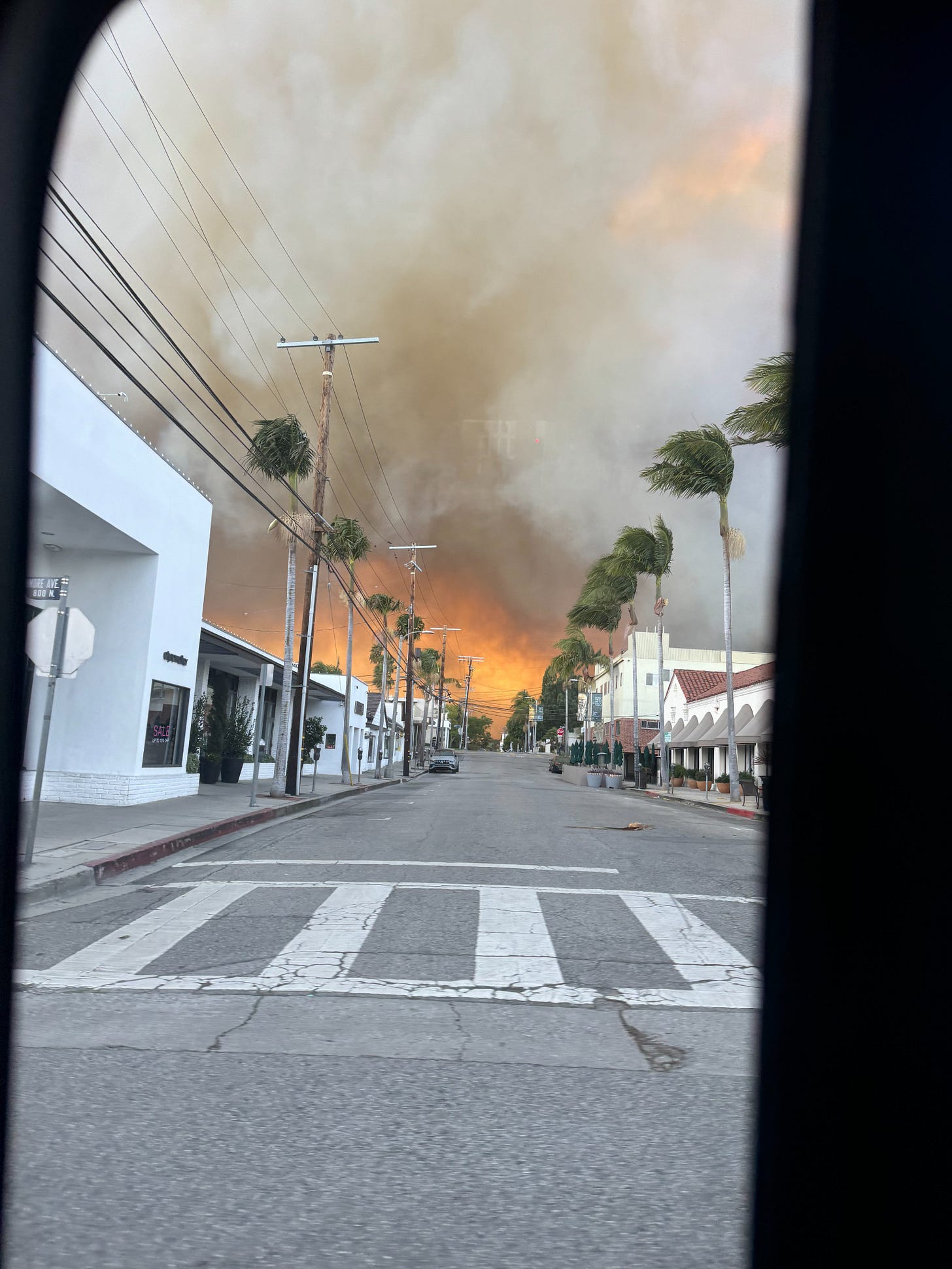

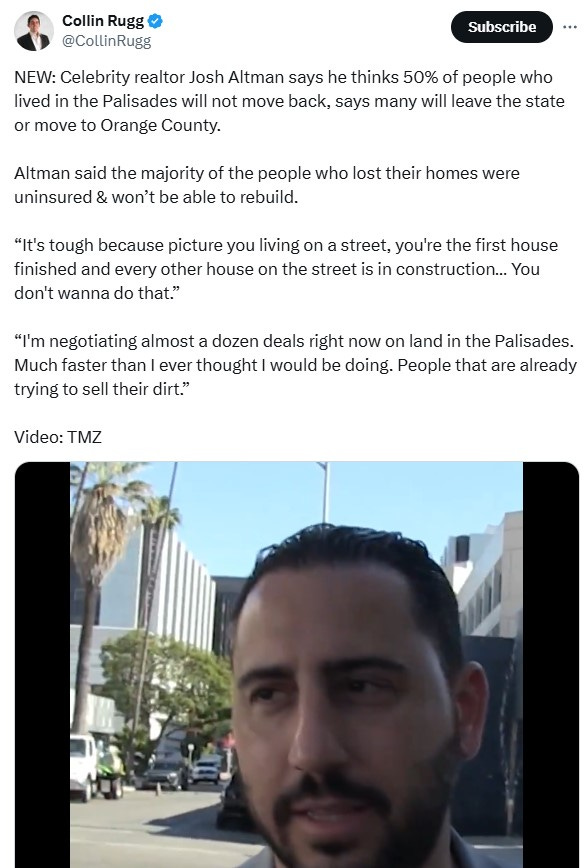
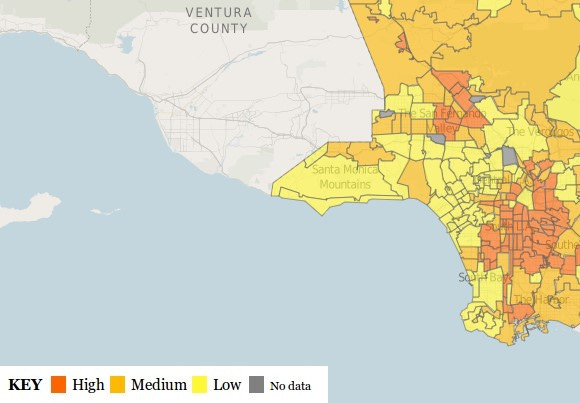

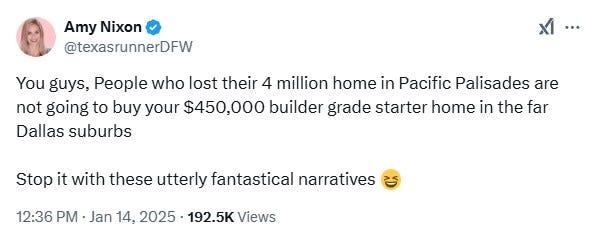
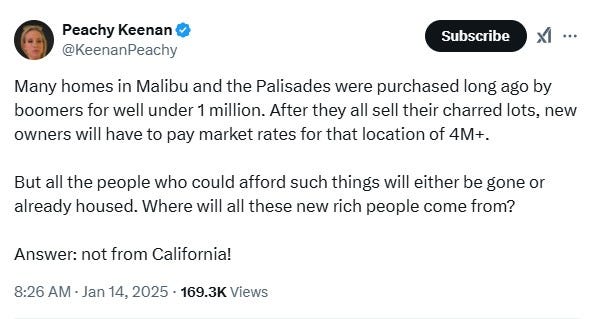
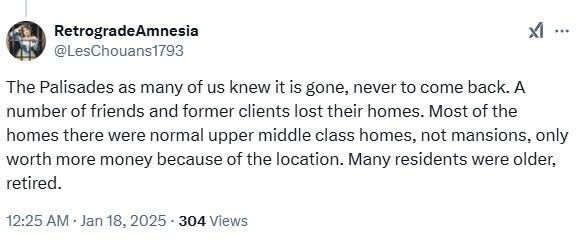

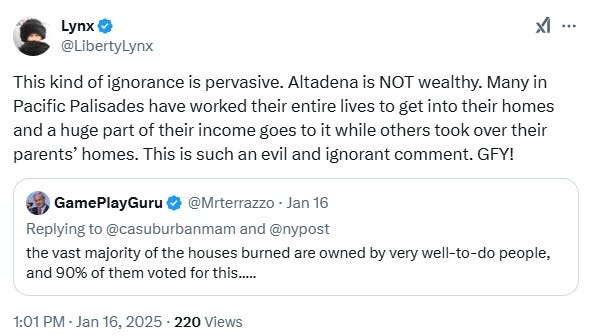
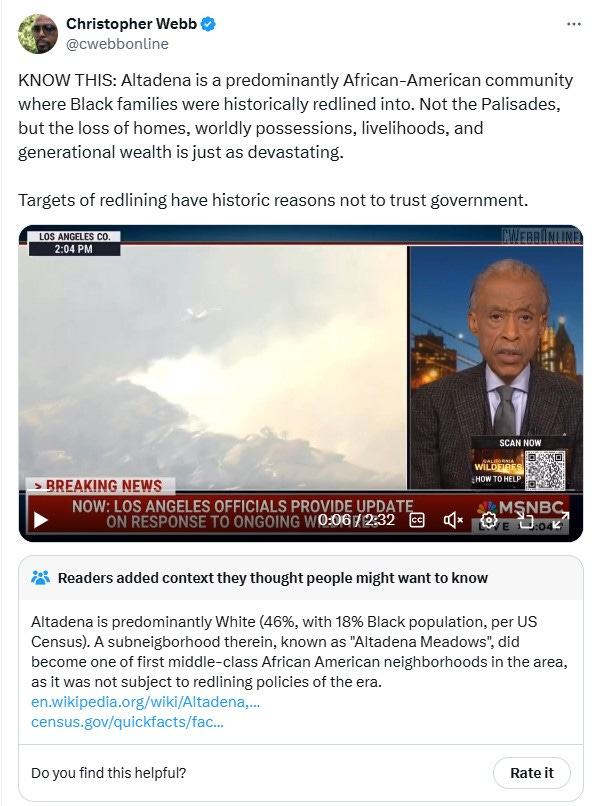

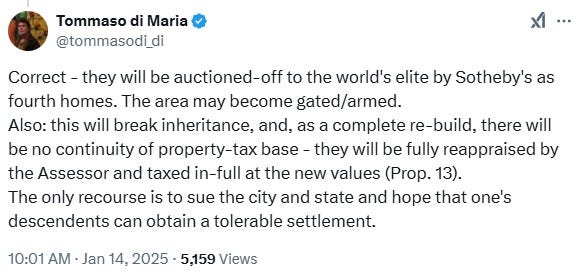
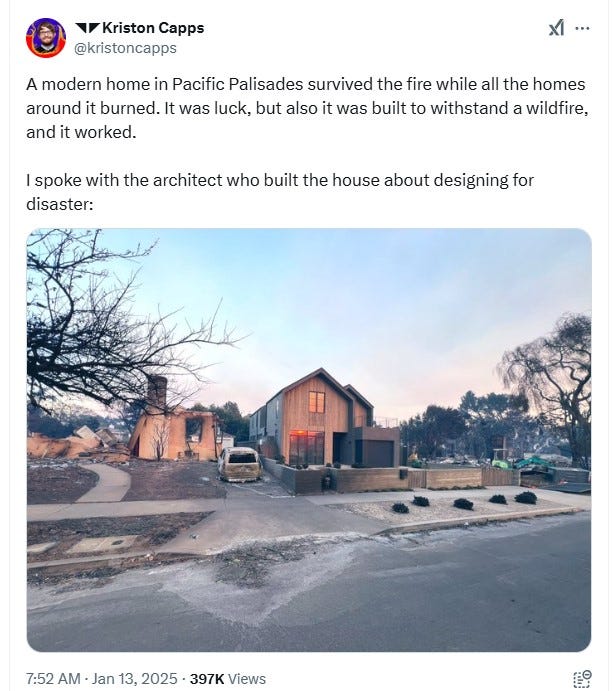
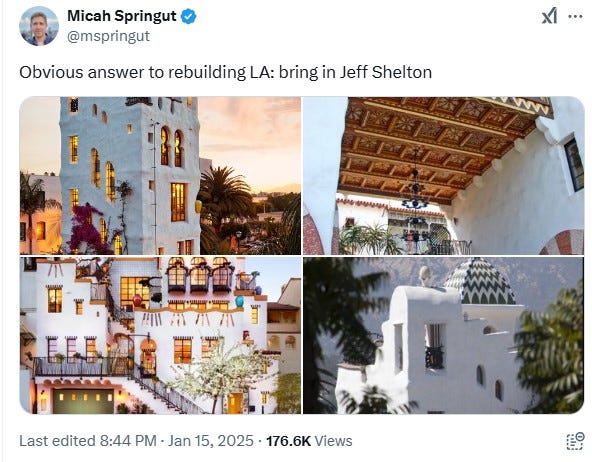









Adore. Yes.
Just stay away from hillsides and canyons.
San Marino, Hancock Park, the flat part of Beverly Hills and parts of Pasadena should be pretty safe when it comes to wildfires. If you have to be on a hill with an ocean view, the Palos Verdes peninsula seems like the safest bet.
Most of the real estate value is in the land, not the improvements. You don’t have to spend $4 million to build a nice house. You can do that for $500,000-$1,000,000. Will the burned-out homeowners get a lot of money for their lots? Hard to say.
The “house-rich” elderly will most likely move into condos. Everyone else who is only “house rich” will have to settle for places like North Hollywood, West Hollywood, Silverlake and Los Feliz.
It’s hard to believe that people (other than those whose policies were recently canceled) didn’t have homeowner’s insurance.
If you want “white-topia”, move to Marin County.
FROM LOST ANGELES
Someone who lost a house in PP said that Pacific Palisades is 90% jews.
A lot of people were uninsured, which this article does not discuss. And I understand that those on the state insurance plan can get no more than $3 million, regardless of how much their house was “worth”.
Here is a dose of reality to consider when discussing rebuilding after a major community fire. The politicians will promise the sun and the moon but it isn’t going to happen easily. There is far too much difficulty involved in getting through all the paper work, collecting insurance money obtaining permits and only then, perhaps, beginning the rebuild:
The main problem is people building in places where wildfires can’t be stopped and the state not allowing insurance companies to raise their premiums accordingly.
My libertarian side says, “Let them build, but also let insurance companies charge what they want.” My socialist side says, “Don’t let them build because — insurance notwithstanding — taxpayers will end up paying a substantial part of the cost.”
I favor my libertarian side — but only slightly.
If California doesn’t end its insane environmentalist policies that prevent freshwater conservation, distribution and storage — if it doesn’t stop preventing the proper management of forests — then the U.S. treasury shouldn’t pay anything.
Federal payment should also be conditioned on the state ending its sanctuary policies and instituting voter ID.
Because of possible mudslides, rebuilding shouldn’t be allowed until after the rainy season.